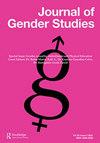In/Visibility和(后苏联)“酷儿衣橱”
IF 1.5
3区 社会学
Q2 SOCIAL ISSUES
引用次数: 0
摘要
本文章由计算机程序翻译,如有差异,请以英文原文为准。
In/Visibility and the (post-soviet) ‘queer closet’
ABSTRACT This article discusses in/visibility regarding sexual identities, the ‘gay closet’, and ‘coming-out’ within the post-soviet context from a queer feminist perspective. Contemporary western-oriented global queer political culture favours individualized visual representation to fight for social acceptance. In many post-soviet and western contexts, however, LGBTIQ+ visibility is increasingly threatened. Accordingly, many choose strategies to sustain their queer lives beyond visibility and public representation. Queer and feminist theory does not offer adequate concepts to account for these forms of resistance. Building on Édouard Glissant, the decolonial and anti-imperialist philosopher, with his demand for the right to opacity, and off queer theory that reconceptualizes the gay closet, such as that of Anna T. I rethink visual in/visibility and the queer closet as space for relationality and recuperation. While Glissant and T. use the concept of opacity primarily on the level of the verbal, I will re-conceptualize opacity as in/visibility on the level of visual discourses. Engaging with the artistic practice of multimedia artist Ruthie Jenrbekova and filmmaker Masha Godovannaya, both of whom play with the in/visibilisation of queerness as artistic strategies, I show how visual opacity can facilitate coalitions beyond identity politics based on nationality, sexuality and/or gender.
求助全文
通过发布文献求助,成功后即可免费获取论文全文。
去求助
来源期刊

Journal of Gender Studies
Multiple-
CiteScore
4.40
自引率
0.00%
发文量
52
期刊介绍:
The Journal of Gender Studies is an interdisciplinary journal which publishes articles relating to gender from a feminist perspective covering a wide range of subject areas including the Social and Natural Sciences, Arts and Popular Culture. Reviews of books and details of forthcoming conferences are also included. The Journal of Gender Studies seeks articles from international sources and aims to take account of a diversity of cultural backgrounds and differences in sexual orientation. It encourages contributions which focus on the experiences of both women and men and welcomes articles, written from a feminist perspective, relating to femininity and masculinity and to the social constructions of relationships between men and women.
 求助内容:
求助内容: 应助结果提醒方式:
应助结果提醒方式:


